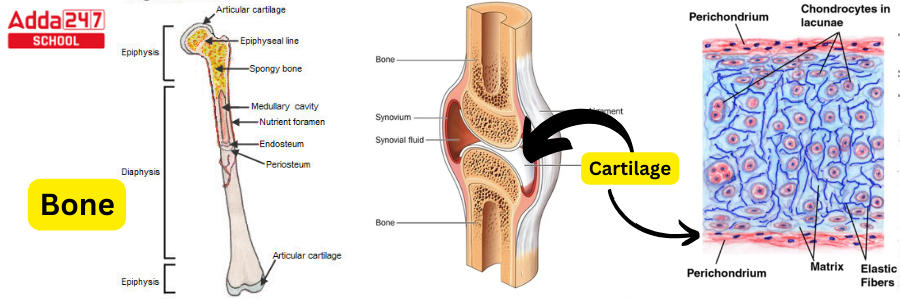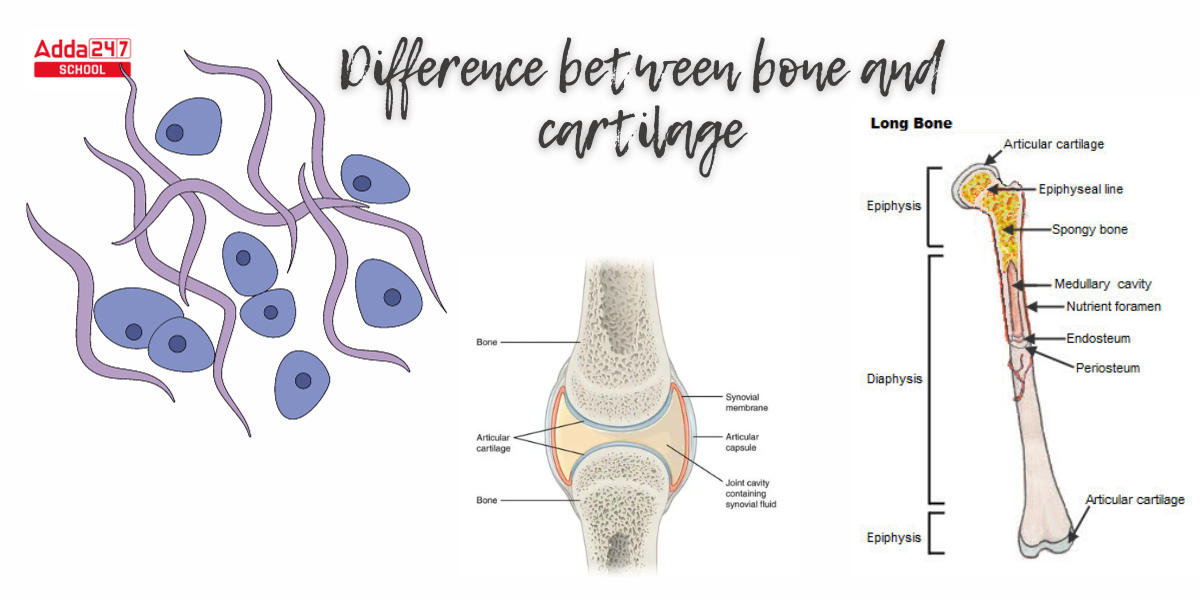Table of Contents
Difference Between Bone and Cartilage: The fundamental difference between bone and cartilage is that bone is a hard, intricate structure that protects organs and gives the body shape. Cartilage is a soft, basic structure that gives joints flexibility and protects joints from external and internal disturbances. Bone and cartilage are two types of connective tissues. The human skeletal system is made up of many types of bones and cartilage. Bone and cartilage both serve crucial roles in safeguarding our body’s internal organs by providing structural support and sites for muscle attachment. Let’s take a closer look at these bones and cartilage, their types, and the major difference between bone and cartilage.
Difference Between Bone and Cartilage
Bone and cartilage provide support and a base for muscle attachment, as well as insulation for many vital organs such as the brain, eyes, heart, and others. Furthermore, they give our body a distinct form and shape. To grasp them better, we must first understand the difference between bone and cartilage. However, before digging into the difference between bone and cartilage, we must first understand the formation of bone and cartilage individually.
What is a Bone?
In vertebrates, bones form the skeletal system. They are composed of collagen, a protein.
- Bones safeguard the body’s organs and serve as a structural support system.
- Bones are composed of thick connective tissue and comprise osteoblasts, osteocytes, and osteoclasts, which are particular bone cells.
- A mature human body is made up of 206 bones. The thigh bone, also known as the Femur, is the biggest and longest bone in the human body. The stapes are the smallest bone in the human ear.
- Bone can also make red and white blood cells as well as store nutrients.
- Their interior and external structures are intricate.
- Calcium Phosphate is an important element found in bones.
- Bones receive an abundant supply of blood via a well-developed vascular system. Bone can generate and replace itself and has an excellent capacity for compression.
Types of Bone
In the human body, there are four different types of bones:
The long bone: This bone type is long and thin. Arm and leg bones are two examples, of eliminating the wrists, ankles, and kneecaps.
Short Bones /ribs: This bone is short and cubed in shape. Short bones make up the wrists and ankles.
The flat bone: Flat bone is elongated and has a wide surface. Ribs, shoulder blades, the breastbone, and cranial bones are just a few examples.
Irregular Bone: It does not have one of the three shapes listed above. The bones of the spine are an example of Irregular bone.
Also Read, Types of Teeth in Human
Difference Between Bone and Cartilage
Understanding the difference between bone and cartilage is important. The cellular structure, density, kinds, and functions of bones and cartilage vary. Cartilage is a thin, flexible tissue that is resistant to compressive forces. Now, continue reading to learn more about cartilage.
What is Cartilage?
Cartilage is a type of soft and stiff connective tissue. In other words, this extracellular matrix is found in connective tissue.
- Cartilage allows for muscle flexibility, bending, and stretching. As a result, you’ll find them in places where support and flexibility are needed, such as the spinal column, joints, ears, and nose.
- This matrix is created by specialized cells known as chondroblasts. Chondroblasts and chondrocytes generate the extracellular matrix, which is composed of around 10% aggrecan, 75% water, and a mixture of collagen fibers and other components. Furthermore, chondroblasts can be seen in the chondrocyte matrix.
- Lacunae are gaps in the space where this cell is located. As a result, you now understand how chondrocytes determine the flexibility of cartilage.
Also Read, Parenchyma- Cells, Tissue, Meaning, Function, and Diagram
Types of Cartilage
There are three kinds of cartilage: fibrocartilage, hyaline cartilage, and elastic cartilage.
Fibrocartilage – Fibrocartilage is the resilient substance that composes up the intervertebral discs as well as the knee, wrist, and temporo-mandibular joints’ intraarticular cartilages.
Hyaline cartilage – Hyaline cartilage tissue is a type of cartilage tissue. It’s the most common type of cartilage, with a glossy, smooth appearance. Hyaline cartilage is found surrounding the bones of free-moving joints. A further example of hyaline cartilage is the tissue present in the walls of the respiratory tract. This includes the bronchi, nose, trachea rings, and rib points.
Elastic cartilage – In the matrix of elastic cartilage, chondrocytes form a thread-like structure composed of elastic fibers. Elastic cartilage provides strength and flexibility to a structure like the external ear while still keeping its shape. It has a perichondrium around it.
Difference Between Bone and Cartilage via Diagrammatic Representation
The figure below depicts the difference between bone and cartilage.

Also Read, Human Digestive System Diagram, Parts and Functions
Difference Between Bone and Cartilage with example in Tabular Form
The difference between bone and cartilage in tabular form is discussed here.
| Difference between bone and cartilage | ||
| Particulars | Bone | Cartilage |
| Definition | Bones are a robust, rigid, inelastic organ that is part of the vertebral skeleton. | Cartilage is a soft, elastic, and stretchy connective tissue that keeps bones from rubbing together. |
| Cell Name | Osteocytes are the name given to bone cells. | Chondrocytes are cartilage cells. |
| Types | There are two kinds of bones: compact and spongy. | There are three forms of cartilage: hyaline cartilage, fibrocartilage, and elastic cartilage. |
| Growth | Bidirectional. They are expanding in both directions. | Unidirectional. It only grows in one direction. |
| Bone Marrow | There is bone marrow present. | It is not present. |
| Blood Vessels | Blood vessels are present. | Blood vessels are absent, nutrients are acquired through diffusion. |
| Blood Supply | a plentiful amount of blood | Blood supply is insufficient. |
| Calcium Salts | Contains calcium salt deposits | Calcium salt deposits may or may not be present. |
| Matrix | It’s both organic and inorganic. | It is entirely natural. |
| Volkmann Canal | There is a Volkmann canal. | The Volkmann canal is missing. |
| Calcium Phosphate | The matrix contains calcium phosphate. | The matrix is missing. |
| Haversian Canal System | There is a Haversian canal system. | There is no Haversian canal system. |
| Funtion | Protect the body from mechanical harm, give a framework and structure for the body, aid in mobility, and create both RBC and WBC. | Supports the respiratory tract, works as a shock absorber between weight-bearing bones, keeps soft appendages in form and flexibility, and prevents friction at joints. |



 NEET UG 2025: Is NEET Previous years Que...
NEET UG 2025: Is NEET Previous years Que...
 JEE Mains Session 2 Result 2025 OUT, Sco...
JEE Mains Session 2 Result 2025 OUT, Sco...
 TS Inter Results 2025 Date for TSBIE 1st...
TS Inter Results 2025 Date for TSBIE 1st...










